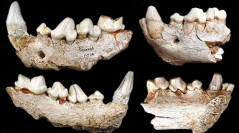

 Geodiversitas
37 (2) - Pages 237-266
Geodiversitas
37 (2) - Pages 237-266The paleontological site of Fouvent-Saint-Andoche (Fouvent-le-Bas, Haute-Saône, France) is a large bone accumulation in a karstic context known since the early nineteenth century. This article focuses on the analysis of 14977 remains from both the historical collection (excavations in 1842) and the material of the recent excavations (1989-1992). A faunal list of 18/19 large mammal species has been established: 12 carnivores (Crocuta crocuta spelaea (Goldfüss, 1832), Panthera (Leo) spelaea (Goldfüss, 1810), Ursus spelaeus Rosenmüller & Heinroth, 1794, Canis lupus Linnaeus, 1758, Vulpes vulpes Linnaeus, 1758, cf. Alopex, Gulo gulo Linnaeus, 1758, Meles meles Linnaeus, 1758, Martes sp., Mustela eversmanii Lesson, 1827, Mustela sp.) and seven/eight ungulates (Mammuthus primigenius Blumenbach, 1799, Coelodonta antiquitatis (Blumenbach, 1799), Megaloceros giganteus Blumenbach, 1799, Cervus elaphus Linnaeus, 1758, Rangifer tarandus (Linnaeus, 1758), Equus germanicus Nehring, 1884, Bos primigenius Bojanus, 1827 and/or Bison priscus Bojanus, 1827). The palaeontological analysis allows us to characterize the evolutionary stage related to each species and to comment their biochronological significance. The detailed study of particular species, such as C. c. spelaea, E. germanicus, or C. antiquitatis improves our knowledge on species associations and their implication in Late Pleistocene hyena dens.
Fouvent-Saint-Andoche, hyena den, OIS3, palaeontology, Carnivora, Ungulata, palaeoenvironmental implications